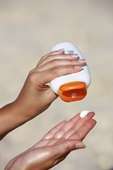Making a common cosmetic and sunblock ingredient safer

Using a particular type of titanium dioxide—a common ingredient in cosmetics, food products, toothpaste and sunscreen—could reduce the potential health risks associated with the widely used compound. The report on the substance, produced by the millions of tons every year for the global market, appears in the ACS journal Chemical Research in Toxicology.
Francesco Turci and colleagues explain that titanium dioxide (TiO2) is generally considered a safe ingredient in commercially available skin products because it doesn't penetrate healthy skin. But there's a catch. Research has shown that TiO2 can cause potentially toxic effects when exposed to ultraviolet light, which is in the sun's rays and is the same kind of light that the compound is supposed to offer protection against. To design a safer TiO2 for human use, the researchers set out to test different forms of the compound, each with its own architecture.
They tested titanium dioxide powders on pig skin (which often substitutes for human skin in these kinds of tests) with indoor lighting, which has very little ultraviolet light in it. They discovered that one of the two most commonly used crystalline forms of TiO2, called rutile, easily washes off and has little effect on skin. Anatase, the other commonly used form, however, was difficult to wash off and damaged the outermost layer of skin—even in low ultraviolet light. It appears to do so via "free radicals," which are associated with skin aging. "The present findings strongly encourage the use of the less reactive, negatively charged rutile to produce safer TiO2-based cosmetic and pharmaceutical products," the researchers conclude.
The article is titled "Crystalline Phase Modulates the Potency of Nanometric TiO2 to Adhere and Perturb the Stratum Corneum of Porcine Skin under Indoor Light."
More information: Crystalline phase modulates the potency of nanometric TiO2 to adhere and perturb the stratum corneum of porcine skin under indoor light, Chem. Res. Toxicol., Just Accepted Manuscript, DOI: 10.1021/tx400285j
Abstract
Nanometric TiO2 is largely employed in cosmetics, but in vitro toxic effects have been reported when nano-TiO2 is exposed to UV light. The photoreactivity of TiO2 largely depends on its crystal phase, namely anatase and rutile. Surface acidity, also dependent on crystal structure, may impart a positive or negative charge to nanomaterial surface and ultimately modulate the particle adhesion to tissues. Three nanometric TiO2 powders with different crystal lattice and surface charge (anatase, rutile and anatase/rutile) have here been employed to investigate the interaction with skin and examine the molecular mechanisms of the TiO2-induced oxidative damage. The strength of the interaction of nano-TiO2 with skin has been revealed by chemiometric mapping (?-XRF and SEM-EDS) after tissue washing. Positively charged anatase and anatase/rutile, but not negatively charged rutile, were strongly held on the skin surface and were able to promote a structural rearrangement of the lipid bilayer in the stratum corneum (DSC and Raman) under controlled indoor illumination (UVA < 1 mW/m2). Under the same conditions, cell-free reactivity tests (ROS-mediated free-radical release and lipoperoxidation) indicated that anatase and anatase/rutile are more reactive than rutile, suggesting a ROS-mediated oxidative mechanism that may alter the structure of the stratum corneum. Both the higher oxidative potential and the stronger adhesion to skin of anatase and anatase/rutile TiO2 may explain the stronger disorganization induced by these two samples and suggest the use of rutile to produce safer TiO2-based cosmetic and pharmaceutical products.
Journal information: Chemical Research in Toxicology
Provided by American Chemical Society



















